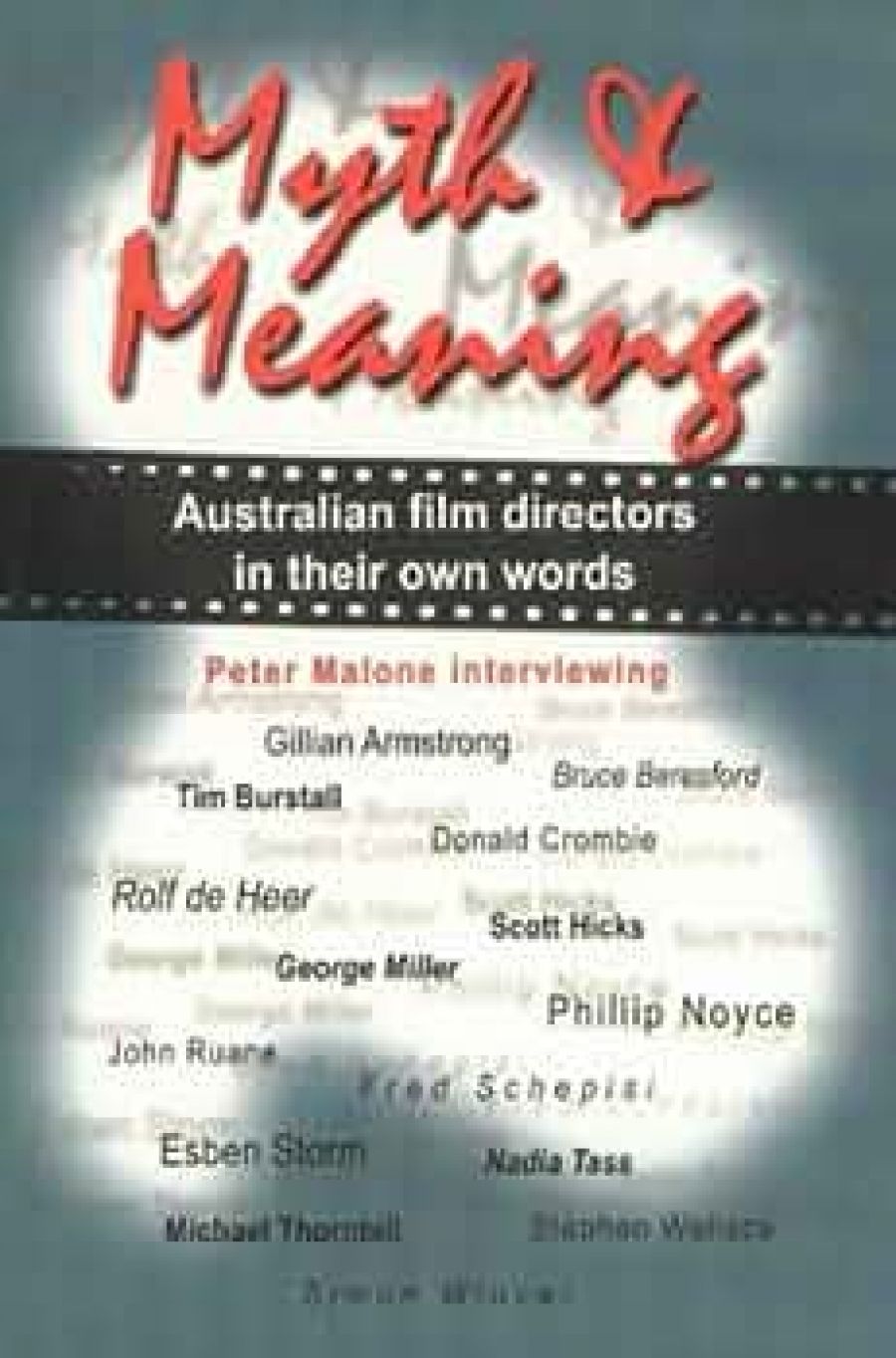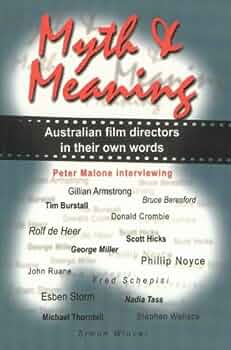
- Free Article: No
- Contents Category: Film
- Review Article: Yes
- Article Title: Some Can, Some Can't
- Online Only: No
- Custom Highlight Text:
The title of this book suggests that it will be less concerned with industrial aspects of Australian cinema than with ideological, but, as if this might limit its scope and resonance, Peter Malone’s subtitle suggests that other lines of inquiry and response might be accommodated as well. This proves to be the case.
- Book 1 Title: Myth and Meaning
- Book 1 Subtitle: Australian Film Directors in Their Own Words
- Book 1 Biblio: Currency Press, $27.50 pb, 216 pp
- Book 1 Cover Small (400 x 600):

- Book 1 Cover (800 x 1200):

Then there is the matter of how useful, how reliable, how articulate the interviewees are. The answer in the present case, and this is probably par for this particular course, is that they vary enormously – from the clearly analytic to the gushing, from the impressively fair-minded to the rabidly defensive. There is no special reason why people gifted in one creative area should necessarily be able to verbalise their contribution. Some can, some can’t, and those who can’t are apt to trip up over their dealings with the purely verbal.
Despite such qualifications, there is nevertheless real value in the enterprise Peter Malone has undertaken: what is on offer is not a factual history or an orderly critical history, but it is history just the same. It is a chronicle of perceptions, not less valuable as insights because they may disagree with each other, and from it emerges – with a nostalgia for the recent past in some cases – some of the most significantly formative preoccupations of Australian cinema and film culture in the last third of the twentieth century.
The interviewees have been unobtrusively guided by Malone’s questions, sometimes the merest nudgings. The interview with him, conducted by Nick Parsons, makes clear where he stands. As a priest, he is interested in film as a barometer of society’s awareness of the spiritual, of matters beyond the material world and not exclusively Christian, but, respected as he is for his tolerance, he doesn’t allow his own convictions to colour the kinds of answers he wants. His generous openness to a wide range of experience works hand in hand with his enthusiasm for the film medium, and with his very detailed knowledge of Australian film and film-makers.
Given that key elements in Australian film-making do emerge from the question-and-answer format (much more reliable than the sort of interview article that uses a few quoted remarks as pegs for the interviewer to hang his shtick on), let us now consider some of these. They fall into two rough groupings: matters to do with film as an industry, as it always is; and those which concern its function as an art, as a vehicle of aesthetic and ideological expression.
With regard to the first grouping, these interviews rehearse some of the recurring problems, though this industrial aspect is not Malone’s chief preoccupation, nor that of Nick Parsons, whose Introduction really does little more than round up the usual Australian cultural stereotypes (the Underdog, Hard Men, etc.). The hoary but endemically relevant issue of the national versus the international, however, raises its head several times, starting with Parsons, who writes of Australian film-makers:
Their subject matter is national, regional, local. But private finance, the lifeblood of our film industry, is global, borderless, and investors expect films to recoup in a global marketplace. There is growing pressure on film-makers to produce stories that are acceptable to an international audience.
As that suggests, the industrial – how to get a film set up financially and how to launch it in the treacherous waters of international competition – may well have a bearing on the sorts of stories that get told. Film-makers need to consider the kind of affect that will move audiences abroad as well as at home, and one thing that surfaces several times is that there may be a danger among Australian directors of valuing self-expression at the expense of communication. A director like Tim Burstall had one eye on the creative aspects of his craft, but was clearly aware that he was also engaged in a business. He recalls his most expensive film of the period, Eliza Fraser (1976), and how the backers, Roadshow, ‘really saw it as very big. They had what we call in the business “a touch of the Hollywoods”. They insisted on overseas stars and all that sort of thing.’ He is one of those who understood that some-times a director may be no more than a ‘hired gun’, as he was on The Naked Country (1985), or the leader of a rescue operation as with Attack Force Z (1979), whereas on others, such as Petersen (1974), the whole enterprise may smack of personal commitment. Burstall stresses, usefully, the prob-lems of raising finance, as does Beresford in his account of how he and Barry Humphries got the idea for The Adventures of Barry McKenzie (1972) and came back to Australia to persuade the newly formed Film Commission to back them. Beresford ruefully acknowledges that, despite the film’s commercial success, it was very bad for him artistically because it got such hostile reviews.
Personally, I wish the book offered more insights into matters like these: how films come to be made, how they are financed, what are seen as strategic manoeuvres of casting, for instance, are often more revealing than the directors’ ruminations on matters of interpretation or aesthetic assessment. The interviews with Burstall, Beresford, Fred Schepisi, Donald Crombie, and the very articulate Michael Thornhill bring back potently the drama of the agitation for an industry in the 1960s and the film-making revival of the 1970s, with its great achievement in the face of recurring obstacles of financing and distribution. (In passing, one notes the absence of that other key figure, Peter Weir; there are no doubt good reasons for his unavailability.) These are some of the most stimulating interviews in the book, and their shrewd analytic appraisal of how to do what they wanted and be acceptable at the same time contrasts with Rolf de Heer’s clotted, cryptic account of religion and hypocrisy and Bad Boy Bubby (1993), or the somewhat gushing incoherence of Nadia Tass (‘It’s my constant pursuit of finding the purity of the real human being’ – or solemnly declaring things ‘incredibly profound’ or ‘absolutely amazing’).
Given the book’s title, it is not surprising to find the line of questioning often tilted towards the representation of religion, spirituality, humanist values, matters of moral concern, and Aboriginal life and culture. Some, like the George Miller who made Mad Max (1979), are outspoken on the latter: ‘Australia is never going to be a grown-up country until it can deal with its indigenous history in a mature way’; and Esben Storm claimed to make the thriller genre piece ‘to reach the great redneck, right-wing mass out there’, who wouldn’t normally support a film focusing on Aboriginal questions. The last sentence of the book is Malone’s: ‘We have arrived at the year 2000 with a lot of questions, and to answer them I think is a religious task, basically, and a spiritual task.’ He has worked to get thoughtful answers from his subjects and they have on the whole cooperated with him, sometimes, one suspects, being urged to confront their contributions from perspectives different from those they are used to. This is surely part of the job description for a good interviewer, which is what Malone clearly is.


Comments powered by CComment